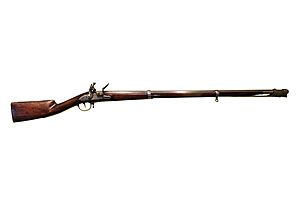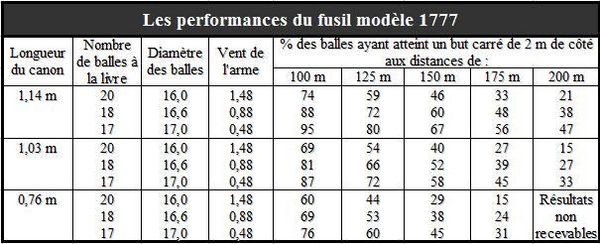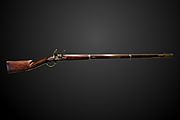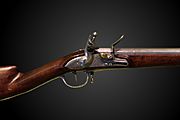Musket Model 1777 facts for kids
Quick facts for kids Musket Modèle 1777 |
|
|---|---|
 |
|
| Type | Musket |
| Place of origin | France |
| Service history | |
| In service | French Army 1777–1840 |
| Used by | France, various native American tribes, United States of America, Haiti, Kingdom of Ireland, First French Empire, Confederation of the Rhine, First Hellenic Republic, Confederate States of America, Pirates, Privateers, Metis, Hunters, |
| Wars | American War of Independence, Haitian Revolution, French Revolutionary Wars, Coalition Wars, United Irishmen Rebellion, Napoleonic Wars, Emmet's Insurrection, Siege of Santo Domingo of 1805, War of 1812, Greek War of Independence, Franco-Trarzan War of 1825, French conquest of Algeria, First Franco-Mexican War, Franco-Moroccan War, French–Tahitian War, American Civil War |
| Production history | |
| Designed | 1777 |
| Manufacturer | Charleville armoury and others |
| Produced | 1777–1839 (all variants) |
| No. built | 7,000,000 |
| Variants | Modèle 1777 corrigé en l'an IX |
| Specifications | |
| Mass | 4.75 kilograms (10.5 lb) |
| Length | 1.52 metres (60 in) |
| Barrel length | 113.7 centimetres (44.8 in) |
|
|
|
| Cartridge | 16.54 mm, 27.19 g lead ball 12.24 black-powder propellant |
| Caliber | 17.5mm (.69 inch) musket ball |
| Action | Flintlock/percussion lock (conversion) |
| Rate of fire | User dependent; usually 2 to 3 rounds a minute |
| Muzzle velocity | Variable 420 m/s (1,400 ft/s) |
| Effective firing range | Variable (50–100 yards) |
| Feed system | Muzzle-loaded |
| Sights | A front sight cast into the upper barrel band |
The Musket Modèle 1777 was a very important type of gun used by soldiers a long time ago. It was one of the most common weapons in Europe. Later, it was updated and called the Modèle 1777 corrigé en l'an IX. This means "Model 1777 corrected in the year IX," which was the year 1800.
This musket was part of a whole family of weapons. There were different versions for different types of soldiers. For example, there were muskets for light infantry (soldiers who moved quickly). There were also versions for artillery (soldiers who used cannons). Even cavalry (soldiers on horseback) had a shorter version called a musketoon.
Contents
The Modèle 1777 Corrected
After the French Revolutionary Wars, a famous leader named Napoleon Bonaparte wanted to improve the musket. He asked for some small changes to be made. These changes were to parts like the firing mechanism, the bayonet, and the wooden stock.
In 1800, these improvements led to the "corrected" model. It was officially known as the "Modèle 1777 corrigé."
Later Updates to the Musket
The Modèle 1777 musket continued to get better over time. More improvements were made in 1816 and again in 1822.
Many of these muskets were originally "flintlock" guns. This meant they used a flint to create a spark and fire the gun. In the mid-1800s, many were changed to a newer system called "percussion cap." This made them more reliable.
How Important Was This Musket?
The Modèle 1777 was produced in huge numbers. About 7 million of these muskets were made. This includes all the different versions from 1800, 1816, and 1822.
Many other countries even copied its design. For example, the Austrian 1798 musket and the Prussian 1809 musket were very similar. Until World War I, no other firearm was made in such large quantities.
French soldiers who were well-trained could fire this musket very quickly. They could usually fire three shots in one minute. A skilled soldier could hit a person-sized target from about 80 yards away. However, hitting anything further away was mostly luck. The musket became very inaccurate at long distances.
Compared to the British Brown Bess musket, the Modèle 1777 had some differences. Its musket balls fit more tightly in the barrel. This meant it was more accurate. But it also meant soldiers couldn't fire as fast. It also caused more "fouling," which is when gunpowder residue builds up inside the barrel.
When Napoleon's army, called the Grande Armée, marched into German countries, they left behind many muskets. Around 750,000 muskets were left when they retreated in 1815. French weapons were still used in Germany until about 1840.
- Details of the musket
Learn More
- Charleville musket – These were earlier muskets that came before the Modèle 1777.
- Brown Bess – This was a famous English musket. It was often used by enemies of France during the Napoleonic Wars.





